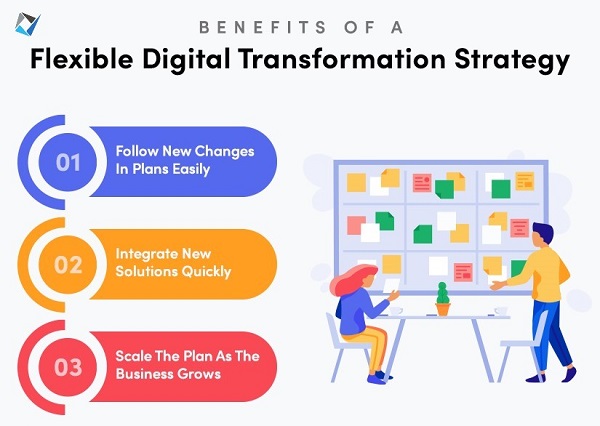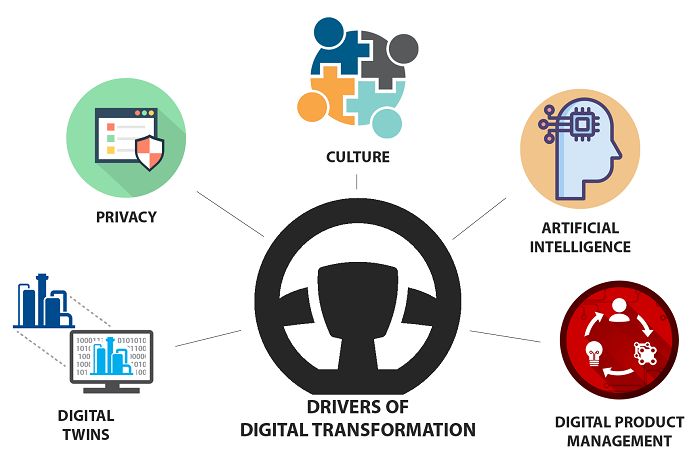Digital transformation (DT) is a term for the transformation of business-to-business and business-to-consumer into a digital platform for services, products, and delivering the value of the brand. It is not just about adding technology to your business. It’s about changing the way your business operates and evolving it for the opportunities and challenges of the new age.
Digital transformation consulting is changing the way we work, interact and enjoy our lives. So, what needs to be done in order to get started in creating the digital transformation? Ten major initial steps need to be taken in order to be successful in digital transformation.
Top 10 Steps Towards Digital Transformation
Traditional organizations are becoming increasingly digital. Whether it is in the field of banking, manufacturing, or healthcare, the need for digital transformation is essential for survival. Top 10 initial steps in digital transformation:
Planning
Planning is one of the initial steps to take for digital transformation. With that said, it is a common misconception that planning is a long-term project, which takes months or years to complete. However, it is important to note that planning is an ongoing process, which should be continually done by IT. According to studies, 84% of leaders think digital transformation planning is the best way to take advantage of opportunities. To do this, you need a plan with a stakeholder map, which is a map of the organization’s stakeholders and the relationships within the organization.
Read: Why organizations are experiencing Digital Transformation
Information technology
Digital transformation has the potential to be transformational for all of our industries. However, to make that happen, it is critical to plan for what you want to achieve and who you want to achieve it with. An effective way to begin is by investing in your internal IT organization. Information technology is an important part of the digital transformation effort. It enables a business to gather, analyze, and act on information to enhance its efficiency. In order to be successful in a digital world, organizations have to transform by moving from a central-office-centered strategy to a distributed one.

Train the workforce
In the future, companies will have to transform themselves into digital organizations to remain competitive. This transformation is already happening. As digital becomes a ubiquitous aspect of business, many companies are already making a number of changes that will ripple into the future. One of these is to make sure that their workforce is ready to handle the demands of digital transformation.
Technical talent continues to be a top priority for many companies. However, a significant issue for many is the lack of skillset that crosses silos between the IT, business, marketing, and sales teams. The industry has been plagued with many issues, such as the inability to harness the talents needed to transform the business. In order to combat this, several companies have created a “universal” approach to skillset training. This requires companies to train the workforce as one of the initial steps to take for digital transformation.
Implement IT
It is said that in order for an organization to be successful in the digital transformation journey, it should begin with a digital strategy. The first step in that strategy is the ‘implementation of IT.’ It should be implemented as an integral part of the overall strategy.
Digital transformation is the concept that many companies would be transformed due to the use of digital technology. Another main reason for digital transformation is the need to increase the efficiency of the companies. With the advancement of technology, the capacity of one company cannot be compared with another. The growth rate of digital transformation can be seen in the fact that the companies are now using digital technology to achieve their targets.
Read: Why Microsoft is leading Digital Transformation is leading the trends
Define the strategy

Ask yourself this question: What exactly is this company’s business strategy? It’s a pretty important question, so it’s not surprising that many executives struggle to answer it with accuracy. Unfortunately, they typically spend too little time on this vital question and then wonder why their company’s digital transformation efforts are stalled.
In order to move forward with digital transformation, organizations first need to define their strategy. This is one of the initial steps to take for digital transformation. Organizations need to define a strategy that supports their strategy and goals. It defines the core information that will drive the organization’s digital transformation.
Develop the roadmap
A Digital Transformation roadmap is one of the initial steps you need to take in order to align the organization with the vision properly. It is an essential tool that every Chief Information Officer (CIO) should have in place to drive digital transformation by driving strategic decisions and initiatives. However, it is not easy to convey a holistic picture of the digital state of your business.
As digital transformation processes go, developing a roadmap for making the transition from a paper-based to a digital organization is a perfect place to start. Making sure that any potential changes you propose are based not only on one’s own needs but also on the needs of those affected.
Fit the model
For any organization seeking to move from the status quo to a digital, agile, and customer-centric model, the initial step is to examine your current business model and operations to determine what is working and what is not. This is especially important when considering the many stages of digital transformation, which require a new mindset, new skills, and new practices.
Execute the strategy

You may be in the middle of digital transformation, or you may not. Regardless, you can’t afford to simply take the first steps and then sit back and hope for the best. Instead, you need to focus on executing the strategy as one of the initial steps to take for digital transformation. Implementing the right digital strategy is the first step to digital transformation.
Executing a strategy is one of the steps that are critical for managers. They need to understand the new technologies that are changing their company quickly. It is also essential as a strategic decision to take early if you don’t want to invest in the wrong technologies.
Measure the results
In the past, digital transformations have been major and costly projects that required detailed planning. While the key to success is to realize the potential benefits these transformations can provide. The next essential step to take is to measure the results. You may have received wisdom that leads you to believe that you need to measure every metric you can think of, when in fact, some of your success metrics don’t require any measurements at all.
Iterate
In the digital transformation world, iterating is the key to success. If you look at every successful digital transformation effort, you will see that the first significant step is often to copy the previous successful effort and iterate from there. So, before you embark on a transformation project, it’s important to ask yourself, “What does the past successful transformation initiative look like?”
Conclusion
It is important first to understand why the organization is embracing digital transformation. Also, how it will benefit the organization’s various stakeholders. For most organizations that are already established, it is likely that they have already started their digital journey. Moreover, they might be running on a well-established digital roadmap. This is clearly a good start and a good foundation. Still, they must not stop there, and they should focus on further transforming their organization to improve efficiencies, adapt to new technologies, and embrace the digital world.
Fill In The Form For – FREE 30 Mins Digital Transformation Consulting










